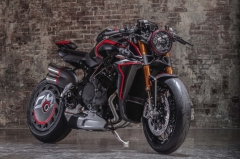Are open face helmets safe?
34.6% of helmet crash damage involves the chin area. Are you willing to risk it?

Without a doubt, open-face helmets are one of the most popular types used by riders in the Philippines—and there are a few good reasons as to why. Open face helmets provide the rider with a substantial amount of ventilation, which is much-needed for the tropical climate and the hot traffic. Open face helmets are also lighter when compared to their full-face counterparts, which can help prevent stress on the neck and shoulders for long rides on the saddle. Lastly, open-face helmets are also considerably more affordable when compared to full-face helmets making them easier to purchase for the budget-conscious rider.
However, open-face helmets do have their drawbacks—and one of the most cited reasons not to buy an open face helmet is rider safety in the event of a crash. Are open helmets as unsafe as some riders may say? Will open face helmets be enough to protect me during most falls? Should you even consider an open face helmet? If you’re asking any of these questions, here are a few things you may want to consider when purchasing your next helmet.
Crash protection

According to a technical 400-page study published in the USA called the Hurt report, crash damage statistics showed that 19.4% of helmet damage is absorbed by the right portion of the chin bar, and 15.2% is absorbed by the left portion. This means that for every motorcycle accident, there is a 34.6% chance that helmet damage will be fully or partially absorbed by the chin bar. With this in mind, it can be alarming to know that open-face helmets do not have chin bars to protect the rider from these kinds of accidents.
The statistics don’t lie—full-face helmets will be more protective for the rider than open-face helmets will be. If you’re looking to maximize the helmet safety you will gain on the road, it may be best to look into full-face helmets for optimum protection. This isn’t to say, however, that open face helmets are absolutely unsafe.
After all, 65.4% of all other crashes happen on other areas of the helmet, and most open face helmets come with face shields that drop all the way down to the area of the chin, which would be helpful for lighter impacts. Just make sure to purchase a helmet that is at least ECE or SNELL rated if you’re looking to optimize for road safety.
Air particles

Ventilation is definitely one of the best attributes of open-face helmets, however, this comes at a cost for certain environments too. Another important safety factor to consider would be exposure to the elements. With an open-face helmet, dust, small road debris, road splash, insects, and other particulates may fly into the face of the rider.
Modern open face helmets are designed well enough to keep all of these particles out of your face, however, the opening near the chin can still allow for these particles to make their way into your face and can become a hazard for rider safety, especially when these particles start to affect your vision and breathing. If you’re riding through rural areas, dusty roads, rainy weather, or even through dense traffic, you may want to consider having a helmet that has adequate padding on the neckline and chin area in order to keep your head clean.
Conclusion

When taking safety into account, open face helmets may not be the best helmet choice for most riding applications. After all, it’s hard to refute the statistics, evidence, and safety benefits of having a full-face helmet. Your head will surely be more protected—whether that’s from dirt, debris, or a crash.
However, open face helmets do have their practical benefits and can be a strong contender for the discerning and experienced rider. They’re practical for short trips through peaceful and well-kept roads, they ventilate well for quick trips under the glaring heat of summer, and they’re lightweight which will be practical for riders who need to keep their necks and shoulders a little bit more relaxed. If you’re looking to purchase an open face helmet, keep in mind to pick one that fits your head best and carries a reputable safety rating in order to protect your head for the many rides to come.
Related Articles
-
5 things to remember when shopping for new motorcycle tires / Featured Article
Here are 5 things to consider when time comes for you to replace the tires on your motorcycle.
-
Can't ride your motorcycle because it's raining? Do these 4 things instead / Featured Article
Here’s a quick listicle of activities you can do if you can’t ride your motorcycle because of bad weather.
-
Which motorcycle jacket should you buy for your riding style? / Featured Article
There are a multitude of options when it comes to riding jackets. Let’s take a closer look at some of the most popular types.
-
Top 5 greatest motorcycle tech advancements of the modern era / Featured Article
Here are what we consider as the top 5 greatest motorcycle innovations of the past decade or so.
-
5 tips to keep thieves away from your motorcycle / Featured Article
Here are 5 things to consider when it comes to keeping your motorcycle safe and secure from prying eyes.
Latest Features
-
Last-minute Christmas gift ideas for your rider friends and family / Featured Article
Struggling to think of gift ideas for your motorcyclist friends and family? Read on to get some inspiration this gift-giving season.
-
Ride a naked sportbike? Get these 5 upgrades first / Featured Article
Here’s a quick list of 5 upgrades to your naked sportbike to enhance your riding experience.
-
Motorcycle 101: The inner workings of a slipper clutch / Featured Article
Slipper clutches are awesome as they make for more forgiving downshifts and a lighter clutch lever. Let’s take a closer look at them and see how they work.








